Research for Business and Tourism: Customer Satisfaction and Service
VerifiedAdded on 2021/05/30
|14
|3021
|224
Report
AI Summary
This report presents a comprehensive research plan focused on the impact of customer service quality on customer satisfaction within the Australian hospitality industry, particularly in hotels. The research employs an applied research design with a descriptive approach, utilizing quantitative methods to gather data through surveys distributed via Qualtrics. The study involves a sample of 100 customers, employing close-ended questionnaires to gather feedback. The data analysis will utilize a regression analysis technique to determine the relationship between the independent variable (customer service) and the dependent variable (customer satisfaction). The report details the ethical considerations, including data protection and informed consent, and outlines a 12-week research plan encompassing topic selection, literature review, data collection, analysis, and report writing. The research aims to provide insights into how customer service impacts customer satisfaction within the hotel industry, considering diverse customer backgrounds and attitudes.
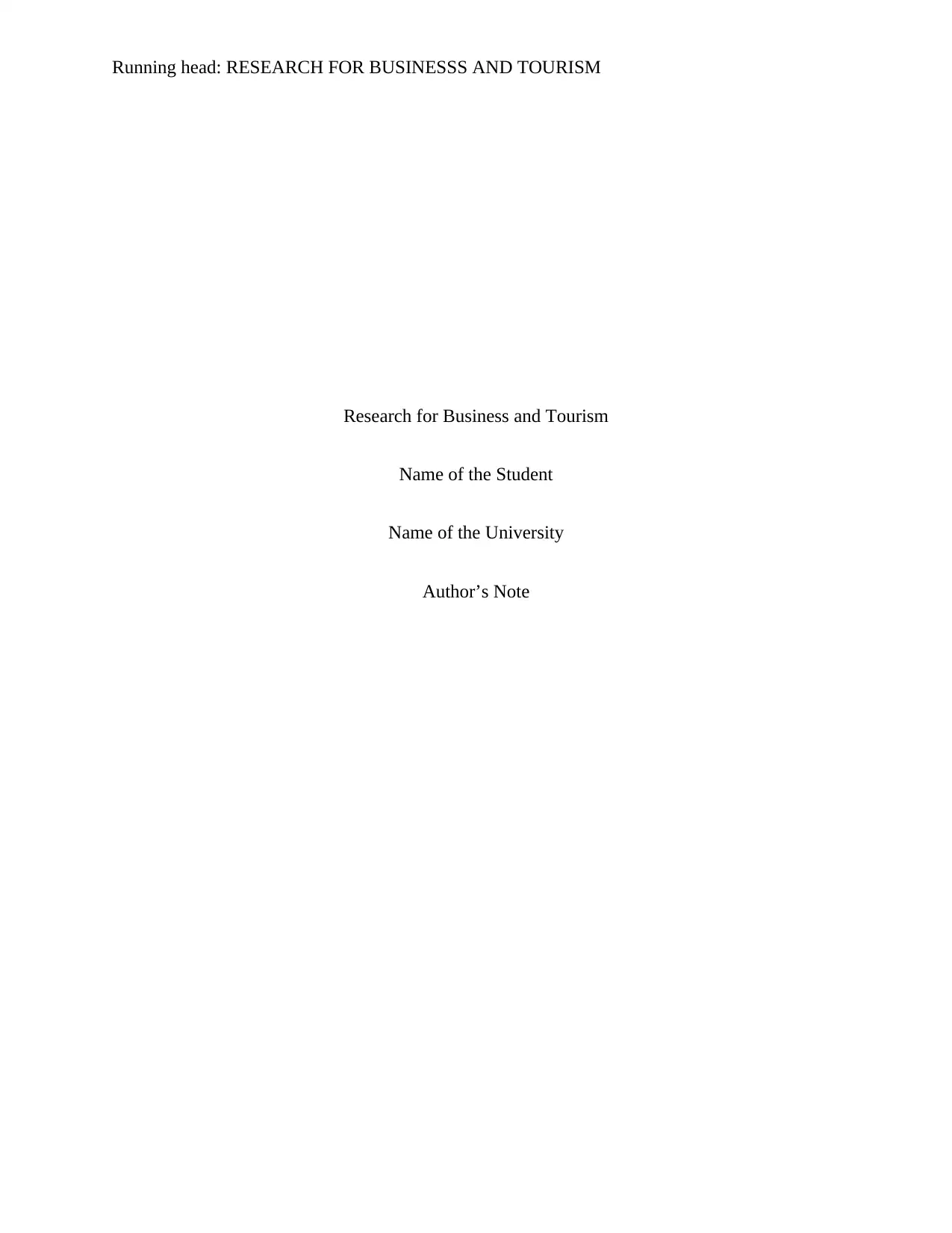
Running head: RESEARCH FOR BUSINESSS AND TOURISM
Research for Business and Tourism
Name of the Student
Name of the University
Author’s Note
Research for Business and Tourism
Name of the Student
Name of the University
Author’s Note
Paraphrase This Document
Need a fresh take? Get an instant paraphrase of this document with our AI Paraphraser
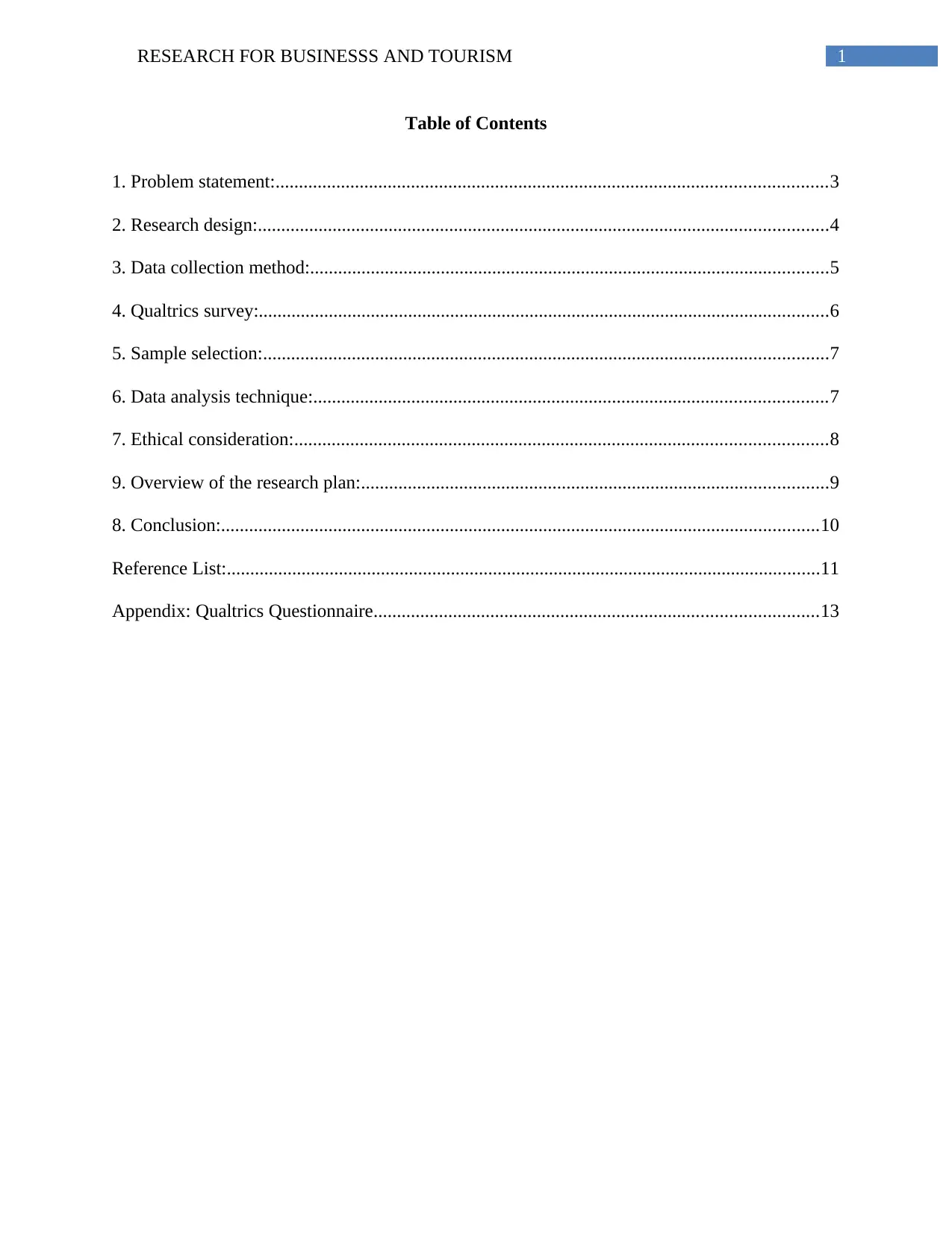
1RESEARCH FOR BUSINESSS AND TOURISM
Table of Contents
1. Problem statement:......................................................................................................................3
2. Research design:..........................................................................................................................4
3. Data collection method:...............................................................................................................5
4. Qualtrics survey:..........................................................................................................................6
5. Sample selection:.........................................................................................................................7
6. Data analysis technique:..............................................................................................................7
7. Ethical consideration:..................................................................................................................8
9. Overview of the research plan:....................................................................................................9
8. Conclusion:................................................................................................................................10
Reference List:...............................................................................................................................11
Appendix: Qualtrics Questionnaire...............................................................................................13
Table of Contents
1. Problem statement:......................................................................................................................3
2. Research design:..........................................................................................................................4
3. Data collection method:...............................................................................................................5
4. Qualtrics survey:..........................................................................................................................6
5. Sample selection:.........................................................................................................................7
6. Data analysis technique:..............................................................................................................7
7. Ethical consideration:..................................................................................................................8
9. Overview of the research plan:....................................................................................................9
8. Conclusion:................................................................................................................................10
Reference List:...............................................................................................................................11
Appendix: Qualtrics Questionnaire...............................................................................................13

2RESEARCH FOR BUSINESSS AND TOURISM
Topic: Customer service quality and customer satisfaction in hospitality industry
1. Problem statement:
The trend of World market has radically changed from agricultural industry to hospitality
with the gradual progress of globalization and internalization. Hospitality industry previously
focused on maintaining superior quality of products so that the business experts can drag the
attention of international customers (Jaakkola and Alexander 2014). With the enhancement of
competitors the business experts have focused on service quality as well. The overarching
concept customer satisfaction implies on customers perceive regarding the delivery of products.
Hospitality sector especially hotel operators have observed that customers in tourism sector are
from different cultural backgrounds as well as attitudes. As a result, people have to face immense
challenges while receiving services from the service providers. A problem is identified within
several hotels of Australia that service providers are not competent enough in dealing with the
people of different cultural backgrounds and attitudes (Ding et al. 2014). In this kind of situation,
service providers have to face innumerable challenges in providing proper services to the
customers.
Automatically, the entire business process fails to maintain its organizational glory and
reputation. Hotels like ADGE apartment, Marriot hotels and Club Hotel are well recognized for
excellent customer services and behavioural approach of the service provider. On the other hand,
it has also been observed that hotels like Quest North Ryde, Atlantis, Mantra on Frome have to
face difficulties in satisfying customers demand due to low customer services. In addition, these
specific hotels are receiving threats from its competitors. However, large numbers of researchers
Topic: Customer service quality and customer satisfaction in hospitality industry
1. Problem statement:
The trend of World market has radically changed from agricultural industry to hospitality
with the gradual progress of globalization and internalization. Hospitality industry previously
focused on maintaining superior quality of products so that the business experts can drag the
attention of international customers (Jaakkola and Alexander 2014). With the enhancement of
competitors the business experts have focused on service quality as well. The overarching
concept customer satisfaction implies on customers perceive regarding the delivery of products.
Hospitality sector especially hotel operators have observed that customers in tourism sector are
from different cultural backgrounds as well as attitudes. As a result, people have to face immense
challenges while receiving services from the service providers. A problem is identified within
several hotels of Australia that service providers are not competent enough in dealing with the
people of different cultural backgrounds and attitudes (Ding et al. 2014). In this kind of situation,
service providers have to face innumerable challenges in providing proper services to the
customers.
Automatically, the entire business process fails to maintain its organizational glory and
reputation. Hotels like ADGE apartment, Marriot hotels and Club Hotel are well recognized for
excellent customer services and behavioural approach of the service provider. On the other hand,
it has also been observed that hotels like Quest North Ryde, Atlantis, Mantra on Frome have to
face difficulties in satisfying customers demand due to low customer services. In addition, these
specific hotels are receiving threats from its competitors. However, large numbers of researchers
⊘ This is a preview!⊘
Do you want full access?
Subscribe today to unlock all pages.

Trusted by 1+ million students worldwide
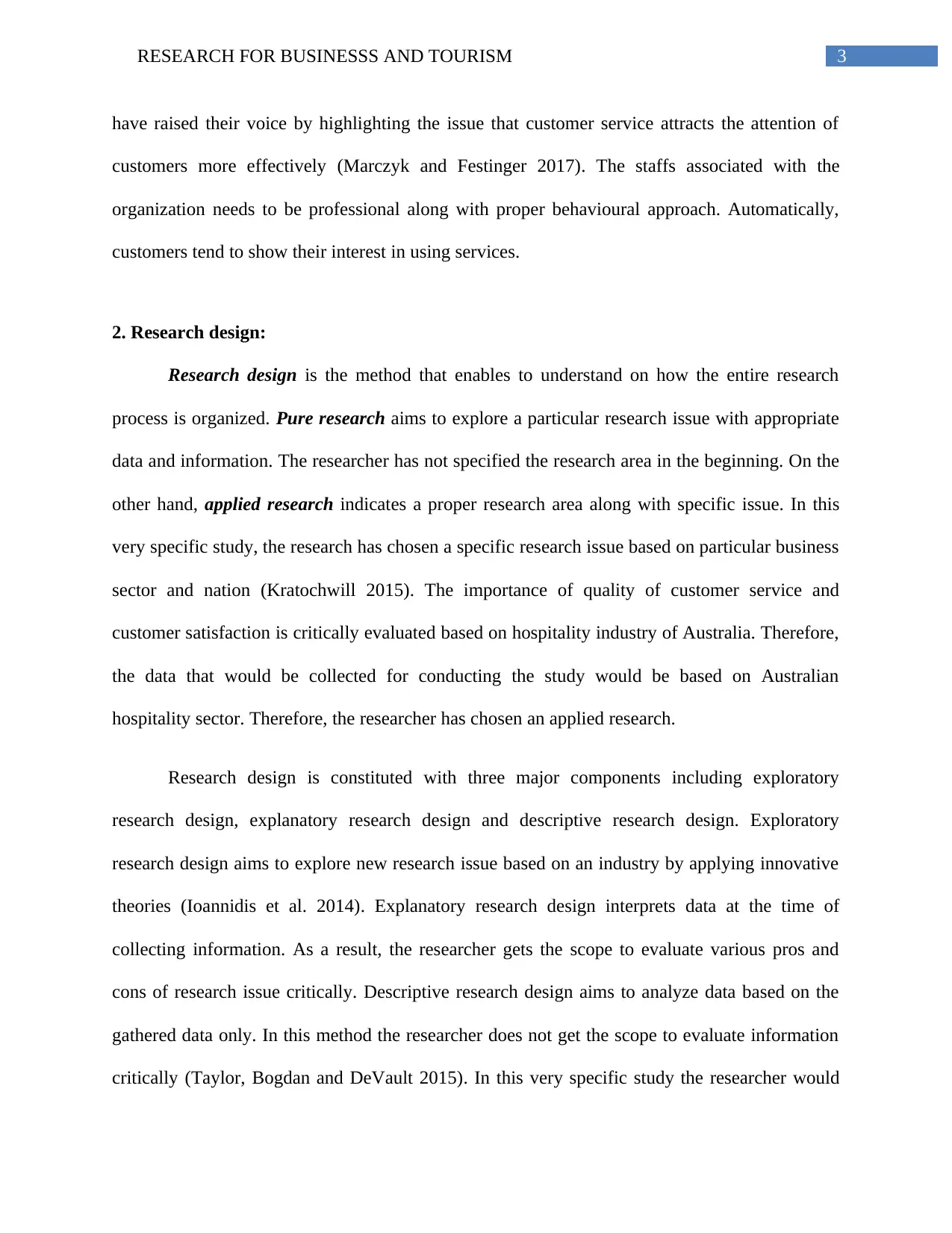
3RESEARCH FOR BUSINESSS AND TOURISM
have raised their voice by highlighting the issue that customer service attracts the attention of
customers more effectively (Marczyk and Festinger 2017). The staffs associated with the
organization needs to be professional along with proper behavioural approach. Automatically,
customers tend to show their interest in using services.
2. Research design:
Research design is the method that enables to understand on how the entire research
process is organized. Pure research aims to explore a particular research issue with appropriate
data and information. The researcher has not specified the research area in the beginning. On the
other hand, applied research indicates a proper research area along with specific issue. In this
very specific study, the research has chosen a specific research issue based on particular business
sector and nation (Kratochwill 2015). The importance of quality of customer service and
customer satisfaction is critically evaluated based on hospitality industry of Australia. Therefore,
the data that would be collected for conducting the study would be based on Australian
hospitality sector. Therefore, the researcher has chosen an applied research.
Research design is constituted with three major components including exploratory
research design, explanatory research design and descriptive research design. Exploratory
research design aims to explore new research issue based on an industry by applying innovative
theories (Ioannidis et al. 2014). Explanatory research design interprets data at the time of
collecting information. As a result, the researcher gets the scope to evaluate various pros and
cons of research issue critically. Descriptive research design aims to analyze data based on the
gathered data only. In this method the researcher does not get the scope to evaluate information
critically (Taylor, Bogdan and DeVault 2015). In this very specific study the researcher would
have raised their voice by highlighting the issue that customer service attracts the attention of
customers more effectively (Marczyk and Festinger 2017). The staffs associated with the
organization needs to be professional along with proper behavioural approach. Automatically,
customers tend to show their interest in using services.
2. Research design:
Research design is the method that enables to understand on how the entire research
process is organized. Pure research aims to explore a particular research issue with appropriate
data and information. The researcher has not specified the research area in the beginning. On the
other hand, applied research indicates a proper research area along with specific issue. In this
very specific study, the research has chosen a specific research issue based on particular business
sector and nation (Kratochwill 2015). The importance of quality of customer service and
customer satisfaction is critically evaluated based on hospitality industry of Australia. Therefore,
the data that would be collected for conducting the study would be based on Australian
hospitality sector. Therefore, the researcher has chosen an applied research.
Research design is constituted with three major components including exploratory
research design, explanatory research design and descriptive research design. Exploratory
research design aims to explore new research issue based on an industry by applying innovative
theories (Ioannidis et al. 2014). Explanatory research design interprets data at the time of
collecting information. As a result, the researcher gets the scope to evaluate various pros and
cons of research issue critically. Descriptive research design aims to analyze data based on the
gathered data only. In this method the researcher does not get the scope to evaluate information
critically (Taylor, Bogdan and DeVault 2015). In this very specific study the researcher would
Paraphrase This Document
Need a fresh take? Get an instant paraphrase of this document with our AI Paraphraser
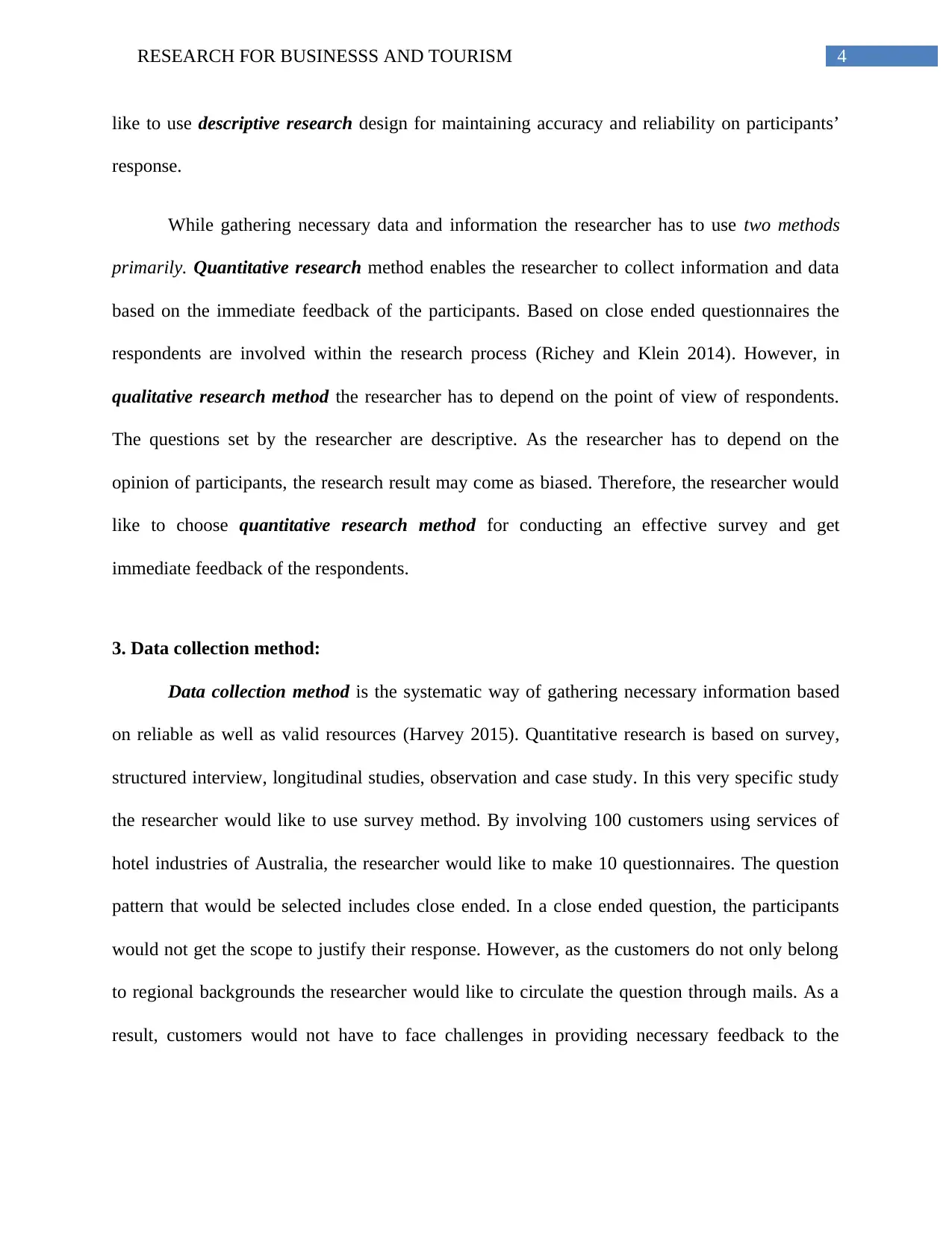
4RESEARCH FOR BUSINESSS AND TOURISM
like to use descriptive research design for maintaining accuracy and reliability on participants’
response.
While gathering necessary data and information the researcher has to use two methods
primarily. Quantitative research method enables the researcher to collect information and data
based on the immediate feedback of the participants. Based on close ended questionnaires the
respondents are involved within the research process (Richey and Klein 2014). However, in
qualitative research method the researcher has to depend on the point of view of respondents.
The questions set by the researcher are descriptive. As the researcher has to depend on the
opinion of participants, the research result may come as biased. Therefore, the researcher would
like to choose quantitative research method for conducting an effective survey and get
immediate feedback of the respondents.
3. Data collection method:
Data collection method is the systematic way of gathering necessary information based
on reliable as well as valid resources (Harvey 2015). Quantitative research is based on survey,
structured interview, longitudinal studies, observation and case study. In this very specific study
the researcher would like to use survey method. By involving 100 customers using services of
hotel industries of Australia, the researcher would like to make 10 questionnaires. The question
pattern that would be selected includes close ended. In a close ended question, the participants
would not get the scope to justify their response. However, as the customers do not only belong
to regional backgrounds the researcher would like to circulate the question through mails. As a
result, customers would not have to face challenges in providing necessary feedback to the
like to use descriptive research design for maintaining accuracy and reliability on participants’
response.
While gathering necessary data and information the researcher has to use two methods
primarily. Quantitative research method enables the researcher to collect information and data
based on the immediate feedback of the participants. Based on close ended questionnaires the
respondents are involved within the research process (Richey and Klein 2014). However, in
qualitative research method the researcher has to depend on the point of view of respondents.
The questions set by the researcher are descriptive. As the researcher has to depend on the
opinion of participants, the research result may come as biased. Therefore, the researcher would
like to choose quantitative research method for conducting an effective survey and get
immediate feedback of the respondents.
3. Data collection method:
Data collection method is the systematic way of gathering necessary information based
on reliable as well as valid resources (Harvey 2015). Quantitative research is based on survey,
structured interview, longitudinal studies, observation and case study. In this very specific study
the researcher would like to use survey method. By involving 100 customers using services of
hotel industries of Australia, the researcher would like to make 10 questionnaires. The question
pattern that would be selected includes close ended. In a close ended question, the participants
would not get the scope to justify their response. However, as the customers do not only belong
to regional backgrounds the researcher would like to circulate the question through mails. As a
result, customers would not have to face challenges in providing necessary feedback to the
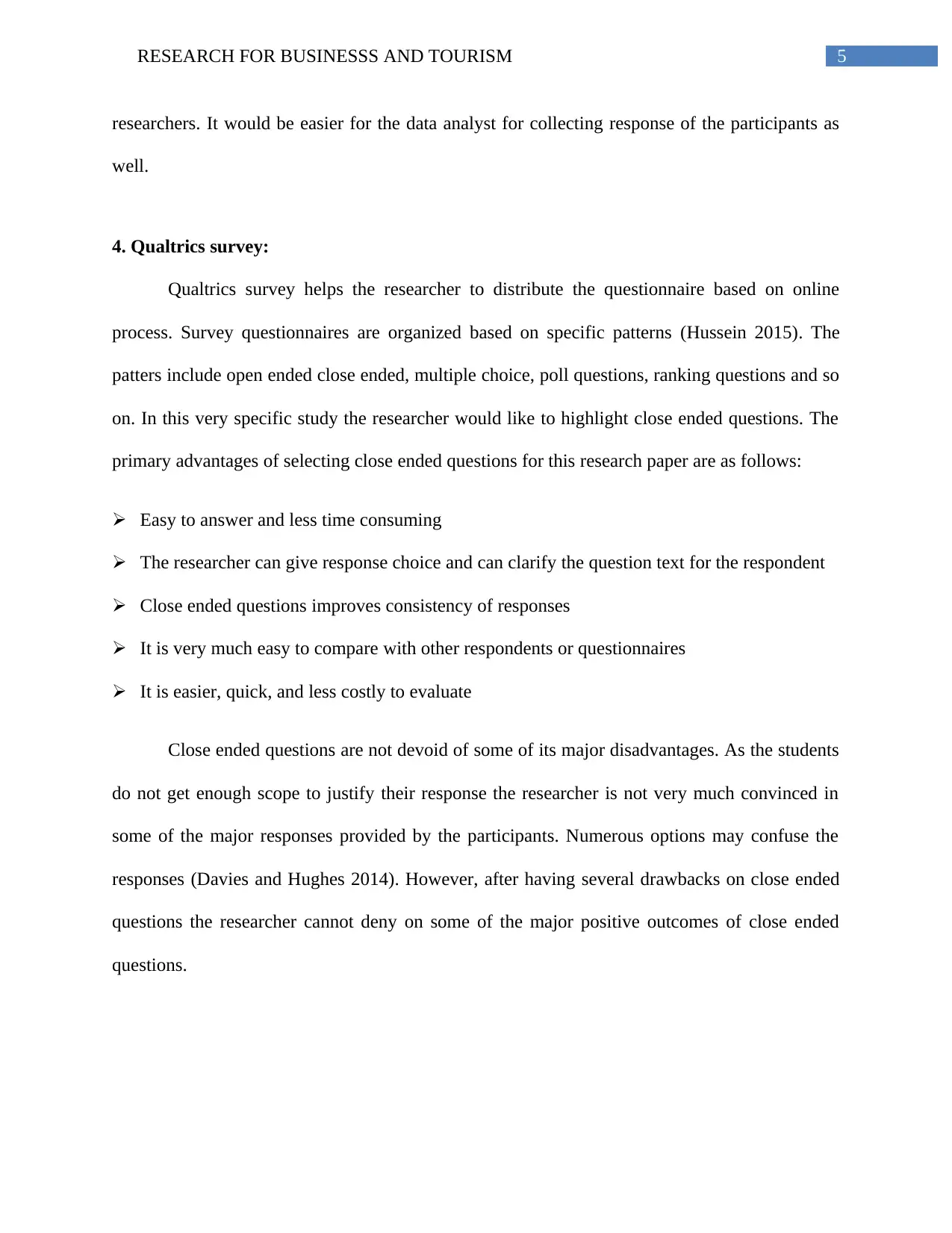
5RESEARCH FOR BUSINESSS AND TOURISM
researchers. It would be easier for the data analyst for collecting response of the participants as
well.
4. Qualtrics survey:
Qualtrics survey helps the researcher to distribute the questionnaire based on online
process. Survey questionnaires are organized based on specific patterns (Hussein 2015). The
patters include open ended close ended, multiple choice, poll questions, ranking questions and so
on. In this very specific study the researcher would like to highlight close ended questions. The
primary advantages of selecting close ended questions for this research paper are as follows:
Easy to answer and less time consuming
The researcher can give response choice and can clarify the question text for the respondent
Close ended questions improves consistency of responses
It is very much easy to compare with other respondents or questionnaires
It is easier, quick, and less costly to evaluate
Close ended questions are not devoid of some of its major disadvantages. As the students
do not get enough scope to justify their response the researcher is not very much convinced in
some of the major responses provided by the participants. Numerous options may confuse the
responses (Davies and Hughes 2014). However, after having several drawbacks on close ended
questions the researcher cannot deny on some of the major positive outcomes of close ended
questions.
researchers. It would be easier for the data analyst for collecting response of the participants as
well.
4. Qualtrics survey:
Qualtrics survey helps the researcher to distribute the questionnaire based on online
process. Survey questionnaires are organized based on specific patterns (Hussein 2015). The
patters include open ended close ended, multiple choice, poll questions, ranking questions and so
on. In this very specific study the researcher would like to highlight close ended questions. The
primary advantages of selecting close ended questions for this research paper are as follows:
Easy to answer and less time consuming
The researcher can give response choice and can clarify the question text for the respondent
Close ended questions improves consistency of responses
It is very much easy to compare with other respondents or questionnaires
It is easier, quick, and less costly to evaluate
Close ended questions are not devoid of some of its major disadvantages. As the students
do not get enough scope to justify their response the researcher is not very much convinced in
some of the major responses provided by the participants. Numerous options may confuse the
responses (Davies and Hughes 2014). However, after having several drawbacks on close ended
questions the researcher cannot deny on some of the major positive outcomes of close ended
questions.
⊘ This is a preview!⊘
Do you want full access?
Subscribe today to unlock all pages.

Trusted by 1+ million students worldwide
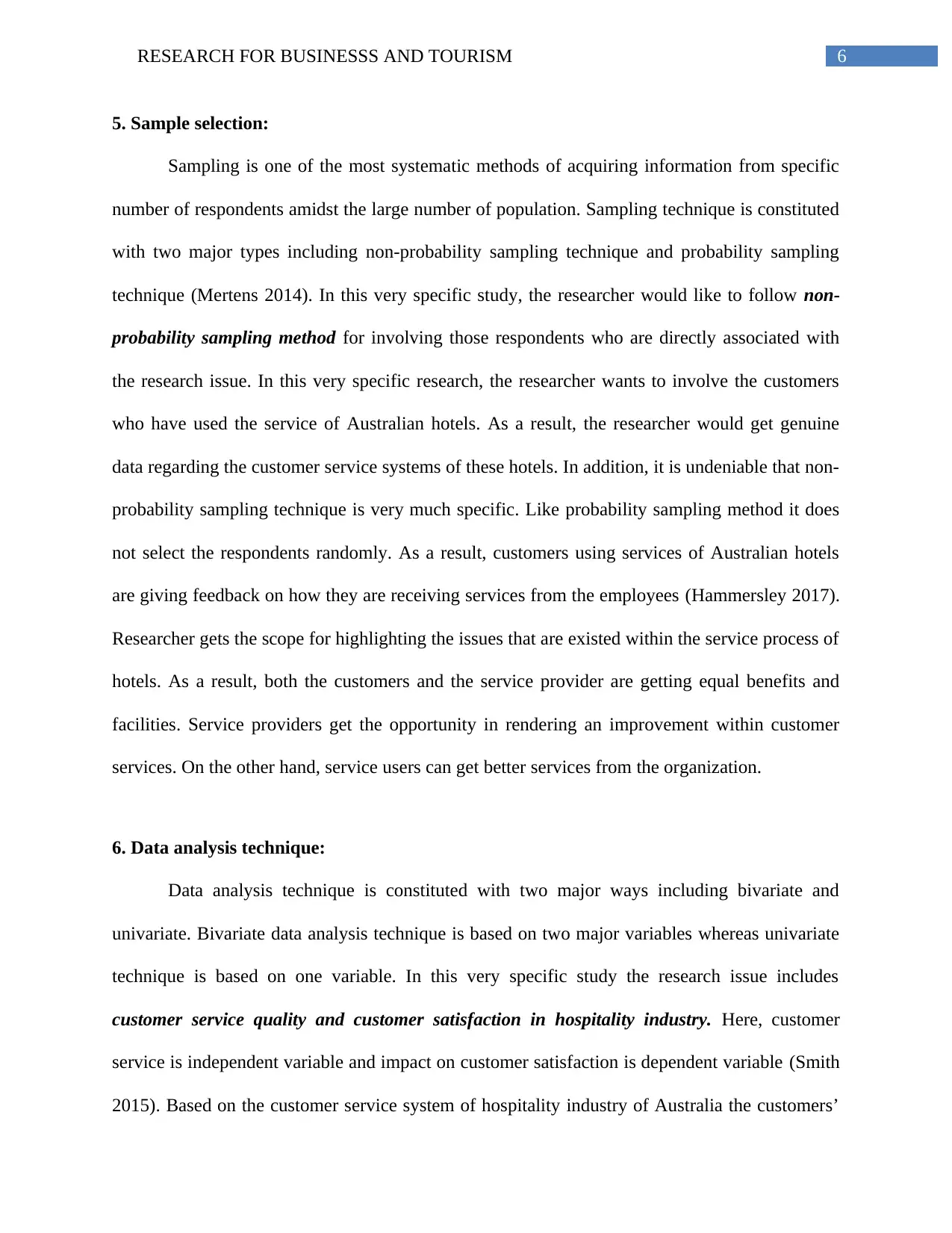
6RESEARCH FOR BUSINESSS AND TOURISM
5. Sample selection:
Sampling is one of the most systematic methods of acquiring information from specific
number of respondents amidst the large number of population. Sampling technique is constituted
with two major types including non-probability sampling technique and probability sampling
technique (Mertens 2014). In this very specific study, the researcher would like to follow non-
probability sampling method for involving those respondents who are directly associated with
the research issue. In this very specific research, the researcher wants to involve the customers
who have used the service of Australian hotels. As a result, the researcher would get genuine
data regarding the customer service systems of these hotels. In addition, it is undeniable that non-
probability sampling technique is very much specific. Like probability sampling method it does
not select the respondents randomly. As a result, customers using services of Australian hotels
are giving feedback on how they are receiving services from the employees (Hammersley 2017).
Researcher gets the scope for highlighting the issues that are existed within the service process of
hotels. As a result, both the customers and the service provider are getting equal benefits and
facilities. Service providers get the opportunity in rendering an improvement within customer
services. On the other hand, service users can get better services from the organization.
6. Data analysis technique:
Data analysis technique is constituted with two major ways including bivariate and
univariate. Bivariate data analysis technique is based on two major variables whereas univariate
technique is based on one variable. In this very specific study the research issue includes
customer service quality and customer satisfaction in hospitality industry. Here, customer
service is independent variable and impact on customer satisfaction is dependent variable (Smith
2015). Based on the customer service system of hospitality industry of Australia the customers’
5. Sample selection:
Sampling is one of the most systematic methods of acquiring information from specific
number of respondents amidst the large number of population. Sampling technique is constituted
with two major types including non-probability sampling technique and probability sampling
technique (Mertens 2014). In this very specific study, the researcher would like to follow non-
probability sampling method for involving those respondents who are directly associated with
the research issue. In this very specific research, the researcher wants to involve the customers
who have used the service of Australian hotels. As a result, the researcher would get genuine
data regarding the customer service systems of these hotels. In addition, it is undeniable that non-
probability sampling technique is very much specific. Like probability sampling method it does
not select the respondents randomly. As a result, customers using services of Australian hotels
are giving feedback on how they are receiving services from the employees (Hammersley 2017).
Researcher gets the scope for highlighting the issues that are existed within the service process of
hotels. As a result, both the customers and the service provider are getting equal benefits and
facilities. Service providers get the opportunity in rendering an improvement within customer
services. On the other hand, service users can get better services from the organization.
6. Data analysis technique:
Data analysis technique is constituted with two major ways including bivariate and
univariate. Bivariate data analysis technique is based on two major variables whereas univariate
technique is based on one variable. In this very specific study the research issue includes
customer service quality and customer satisfaction in hospitality industry. Here, customer
service is independent variable and impact on customer satisfaction is dependent variable (Smith
2015). Based on the customer service system of hospitality industry of Australia the customers’
Paraphrase This Document
Need a fresh take? Get an instant paraphrase of this document with our AI Paraphraser
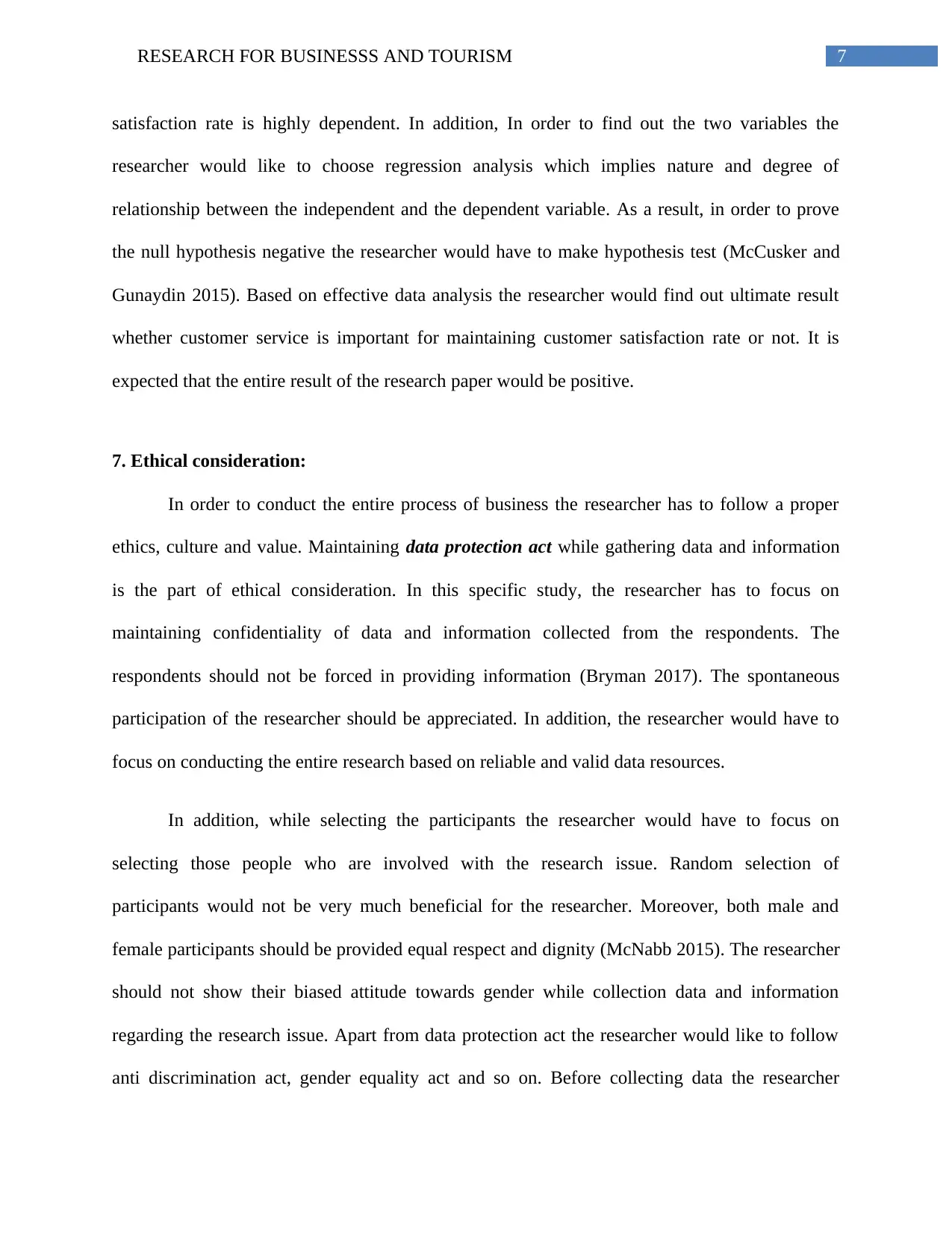
7RESEARCH FOR BUSINESSS AND TOURISM
satisfaction rate is highly dependent. In addition, In order to find out the two variables the
researcher would like to choose regression analysis which implies nature and degree of
relationship between the independent and the dependent variable. As a result, in order to prove
the null hypothesis negative the researcher would have to make hypothesis test (McCusker and
Gunaydin 2015). Based on effective data analysis the researcher would find out ultimate result
whether customer service is important for maintaining customer satisfaction rate or not. It is
expected that the entire result of the research paper would be positive.
7. Ethical consideration:
In order to conduct the entire process of business the researcher has to follow a proper
ethics, culture and value. Maintaining data protection act while gathering data and information
is the part of ethical consideration. In this specific study, the researcher has to focus on
maintaining confidentiality of data and information collected from the respondents. The
respondents should not be forced in providing information (Bryman 2017). The spontaneous
participation of the researcher should be appreciated. In addition, the researcher would have to
focus on conducting the entire research based on reliable and valid data resources.
In addition, while selecting the participants the researcher would have to focus on
selecting those people who are involved with the research issue. Random selection of
participants would not be very much beneficial for the researcher. Moreover, both male and
female participants should be provided equal respect and dignity (McNabb 2015). The researcher
should not show their biased attitude towards gender while collection data and information
regarding the research issue. Apart from data protection act the researcher would like to follow
anti discrimination act, gender equality act and so on. Before collecting data the researcher
satisfaction rate is highly dependent. In addition, In order to find out the two variables the
researcher would like to choose regression analysis which implies nature and degree of
relationship between the independent and the dependent variable. As a result, in order to prove
the null hypothesis negative the researcher would have to make hypothesis test (McCusker and
Gunaydin 2015). Based on effective data analysis the researcher would find out ultimate result
whether customer service is important for maintaining customer satisfaction rate or not. It is
expected that the entire result of the research paper would be positive.
7. Ethical consideration:
In order to conduct the entire process of business the researcher has to follow a proper
ethics, culture and value. Maintaining data protection act while gathering data and information
is the part of ethical consideration. In this specific study, the researcher has to focus on
maintaining confidentiality of data and information collected from the respondents. The
respondents should not be forced in providing information (Bryman 2017). The spontaneous
participation of the researcher should be appreciated. In addition, the researcher would have to
focus on conducting the entire research based on reliable and valid data resources.
In addition, while selecting the participants the researcher would have to focus on
selecting those people who are involved with the research issue. Random selection of
participants would not be very much beneficial for the researcher. Moreover, both male and
female participants should be provided equal respect and dignity (McNabb 2015). The researcher
should not show their biased attitude towards gender while collection data and information
regarding the research issue. Apart from data protection act the researcher would like to follow
anti discrimination act, gender equality act and so on. Before collecting data the researcher
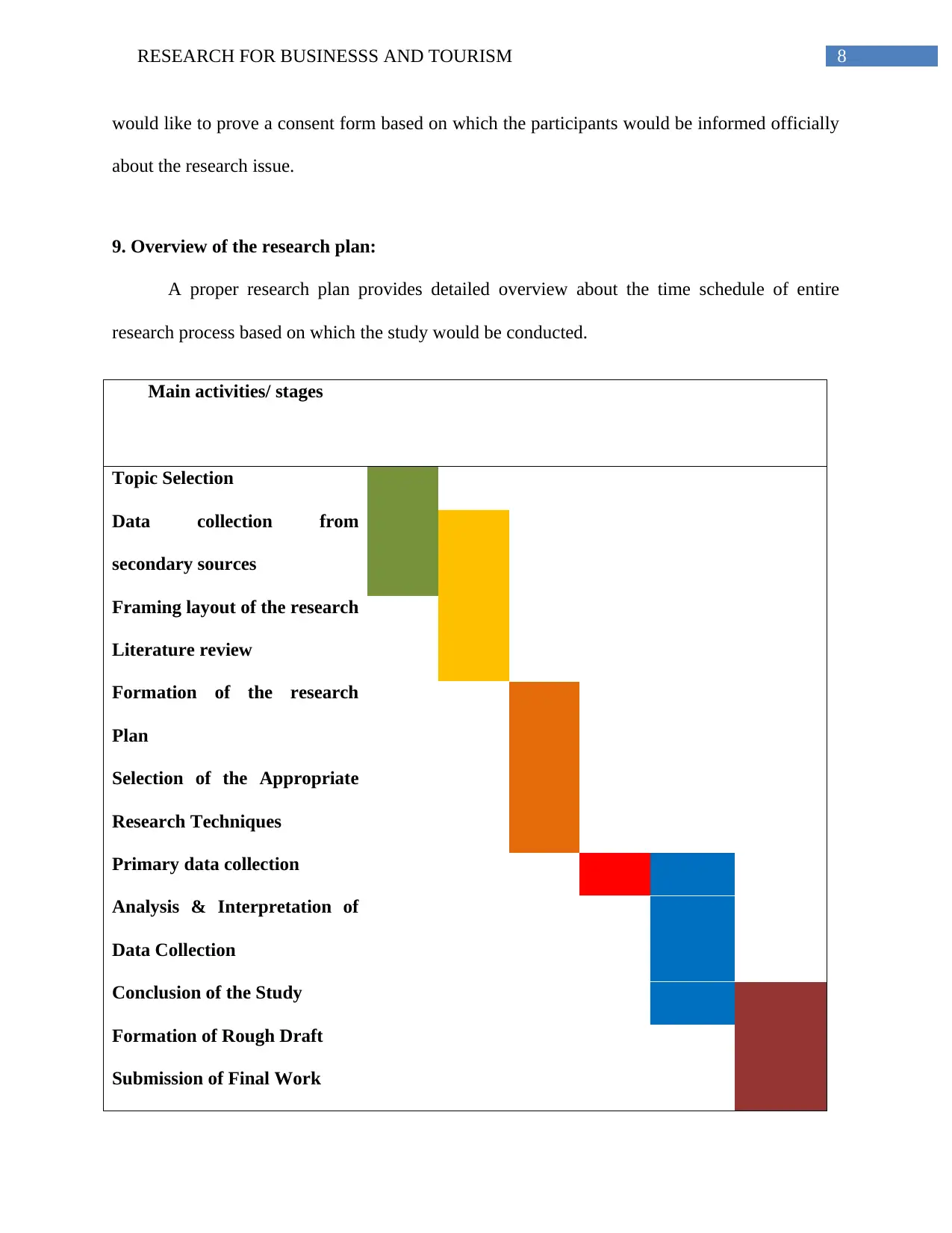
8RESEARCH FOR BUSINESSS AND TOURISM
would like to prove a consent form based on which the participants would be informed officially
about the research issue.
9. Overview of the research plan:
A proper research plan provides detailed overview about the time schedule of entire
research process based on which the study would be conducted.
Main activities/ stages 1st-2nd
Week
3rd- 4th
Week
5th- 6th
Week
7th-8th
Week
9th- 10th
Week
11th- 12th
Week
Topic Selection
Data collection from
secondary sources
Framing layout of the research
Literature review
Formation of the research
Plan
Selection of the Appropriate
Research Techniques
Primary data collection
Analysis & Interpretation of
Data Collection
Conclusion of the Study
Formation of Rough Draft
Submission of Final Work
would like to prove a consent form based on which the participants would be informed officially
about the research issue.
9. Overview of the research plan:
A proper research plan provides detailed overview about the time schedule of entire
research process based on which the study would be conducted.
Main activities/ stages 1st-2nd
Week
3rd- 4th
Week
5th- 6th
Week
7th-8th
Week
9th- 10th
Week
11th- 12th
Week
Topic Selection
Data collection from
secondary sources
Framing layout of the research
Literature review
Formation of the research
Plan
Selection of the Appropriate
Research Techniques
Primary data collection
Analysis & Interpretation of
Data Collection
Conclusion of the Study
Formation of Rough Draft
Submission of Final Work
⊘ This is a preview!⊘
Do you want full access?
Subscribe today to unlock all pages.

Trusted by 1+ million students worldwide
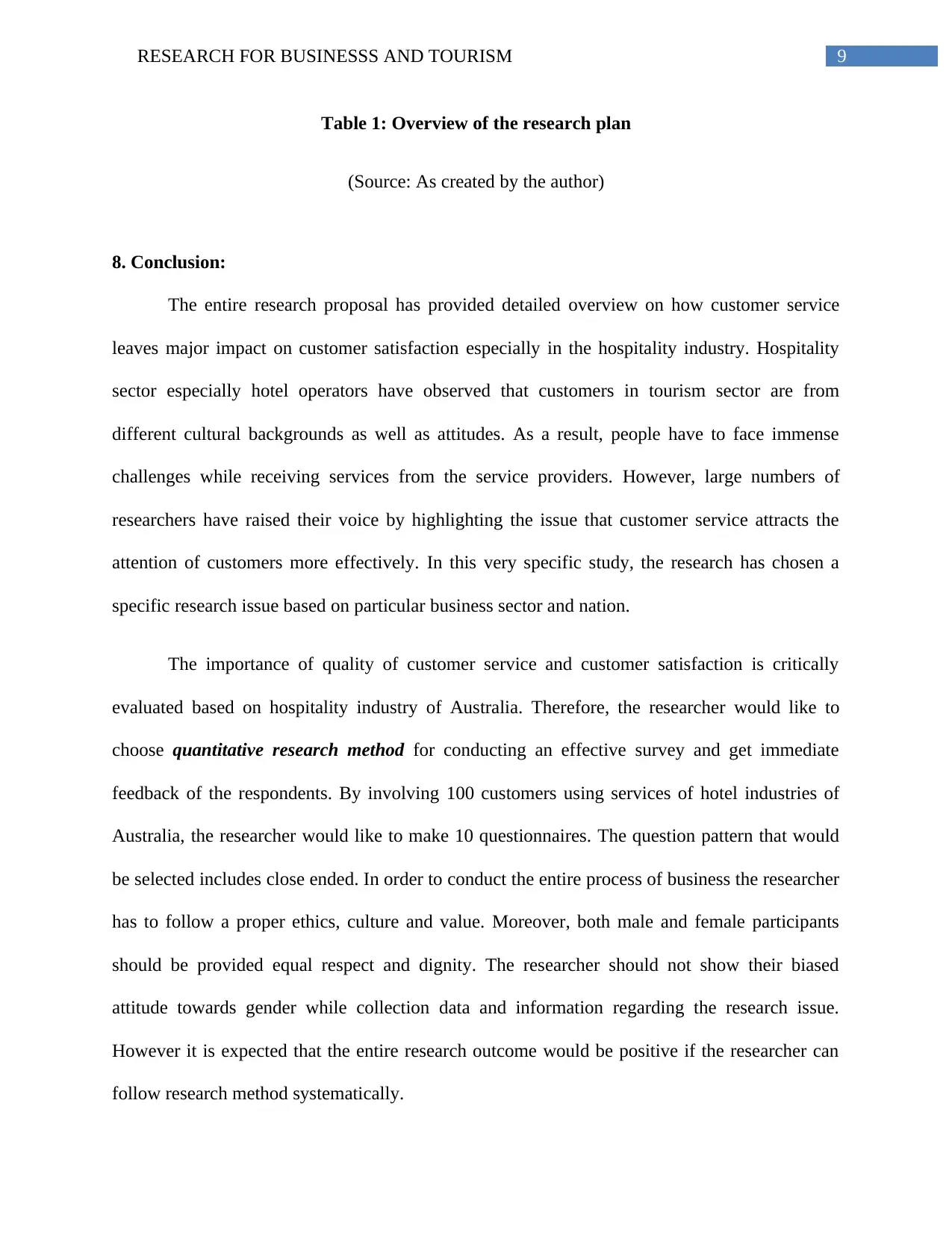
9RESEARCH FOR BUSINESSS AND TOURISM
Table 1: Overview of the research plan
(Source: As created by the author)
8. Conclusion:
The entire research proposal has provided detailed overview on how customer service
leaves major impact on customer satisfaction especially in the hospitality industry. Hospitality
sector especially hotel operators have observed that customers in tourism sector are from
different cultural backgrounds as well as attitudes. As a result, people have to face immense
challenges while receiving services from the service providers. However, large numbers of
researchers have raised their voice by highlighting the issue that customer service attracts the
attention of customers more effectively. In this very specific study, the research has chosen a
specific research issue based on particular business sector and nation.
The importance of quality of customer service and customer satisfaction is critically
evaluated based on hospitality industry of Australia. Therefore, the researcher would like to
choose quantitative research method for conducting an effective survey and get immediate
feedback of the respondents. By involving 100 customers using services of hotel industries of
Australia, the researcher would like to make 10 questionnaires. The question pattern that would
be selected includes close ended. In order to conduct the entire process of business the researcher
has to follow a proper ethics, culture and value. Moreover, both male and female participants
should be provided equal respect and dignity. The researcher should not show their biased
attitude towards gender while collection data and information regarding the research issue.
However it is expected that the entire research outcome would be positive if the researcher can
follow research method systematically.
Table 1: Overview of the research plan
(Source: As created by the author)
8. Conclusion:
The entire research proposal has provided detailed overview on how customer service
leaves major impact on customer satisfaction especially in the hospitality industry. Hospitality
sector especially hotel operators have observed that customers in tourism sector are from
different cultural backgrounds as well as attitudes. As a result, people have to face immense
challenges while receiving services from the service providers. However, large numbers of
researchers have raised their voice by highlighting the issue that customer service attracts the
attention of customers more effectively. In this very specific study, the research has chosen a
specific research issue based on particular business sector and nation.
The importance of quality of customer service and customer satisfaction is critically
evaluated based on hospitality industry of Australia. Therefore, the researcher would like to
choose quantitative research method for conducting an effective survey and get immediate
feedback of the respondents. By involving 100 customers using services of hotel industries of
Australia, the researcher would like to make 10 questionnaires. The question pattern that would
be selected includes close ended. In order to conduct the entire process of business the researcher
has to follow a proper ethics, culture and value. Moreover, both male and female participants
should be provided equal respect and dignity. The researcher should not show their biased
attitude towards gender while collection data and information regarding the research issue.
However it is expected that the entire research outcome would be positive if the researcher can
follow research method systematically.
Paraphrase This Document
Need a fresh take? Get an instant paraphrase of this document with our AI Paraphraser

10RESEARCH FOR BUSINESSS AND TOURISM
Reference List:
Bryman, A., 2017. Quantitative and qualitative research: further reflections on their integration.
In Mixing methods: Qualitative and quantitative research (pp. 57-78). Routledge.
Davies, M.B. and Hughes, N., 2014. Doing a successful research project: Using qualitative or
quantitative methods. Palgrave Macmillan.
Ding, S., Yang, S., Zhang, Y., Liang, C. and Xia, C., 2014. Combining QoS prediction and
customer satisfaction estimation to solve cloud service trustworthiness evaluation
problems. Knowledge-Based Systems, 56, pp.216-225.
Hammersley, M., 2017. Deconstructing the qualitative-quantitative divide 1. In Mixing methods:
Qualitative and quantitative research (pp. 39-55). Routledge.
Harvey, L., 2015. Beyond member-checking: A dialogic approach to the research
interview. International Journal of Research & Method in Education, 38(1), pp.23-38.
Hussein, A., 2015. The use of Triangulation in Social Sciences Research: Can qualitative and
quantitative methods be combined?. Journal of comparative social work, 4(1).
Ioannidis, J.P., Greenland, S., Hlatky, M.A., Khoury, M.J., Macleod, M.R., Moher, D., Schulz,
K.F. and Tibshirani, R., 2014. Increasing value and reducing waste in research design, conduct,
and analysis. The Lancet, 383(9912), pp.166-175.
Jaakkola, E. and Alexander, M., 2014. The role of customer engagement behavior in value co-
creation: a service system perspective. Journal of Service Research, 17(3), pp.247-261.
Kratochwill, T.R., 2015. Single-case research design and analysis: An overview. In Single-Case
Research Design and Analysis (Psychology Revivals) (pp. 13-26). Routledge.
Reference List:
Bryman, A., 2017. Quantitative and qualitative research: further reflections on their integration.
In Mixing methods: Qualitative and quantitative research (pp. 57-78). Routledge.
Davies, M.B. and Hughes, N., 2014. Doing a successful research project: Using qualitative or
quantitative methods. Palgrave Macmillan.
Ding, S., Yang, S., Zhang, Y., Liang, C. and Xia, C., 2014. Combining QoS prediction and
customer satisfaction estimation to solve cloud service trustworthiness evaluation
problems. Knowledge-Based Systems, 56, pp.216-225.
Hammersley, M., 2017. Deconstructing the qualitative-quantitative divide 1. In Mixing methods:
Qualitative and quantitative research (pp. 39-55). Routledge.
Harvey, L., 2015. Beyond member-checking: A dialogic approach to the research
interview. International Journal of Research & Method in Education, 38(1), pp.23-38.
Hussein, A., 2015. The use of Triangulation in Social Sciences Research: Can qualitative and
quantitative methods be combined?. Journal of comparative social work, 4(1).
Ioannidis, J.P., Greenland, S., Hlatky, M.A., Khoury, M.J., Macleod, M.R., Moher, D., Schulz,
K.F. and Tibshirani, R., 2014. Increasing value and reducing waste in research design, conduct,
and analysis. The Lancet, 383(9912), pp.166-175.
Jaakkola, E. and Alexander, M., 2014. The role of customer engagement behavior in value co-
creation: a service system perspective. Journal of Service Research, 17(3), pp.247-261.
Kratochwill, T.R., 2015. Single-case research design and analysis: An overview. In Single-Case
Research Design and Analysis (Psychology Revivals) (pp. 13-26). Routledge.
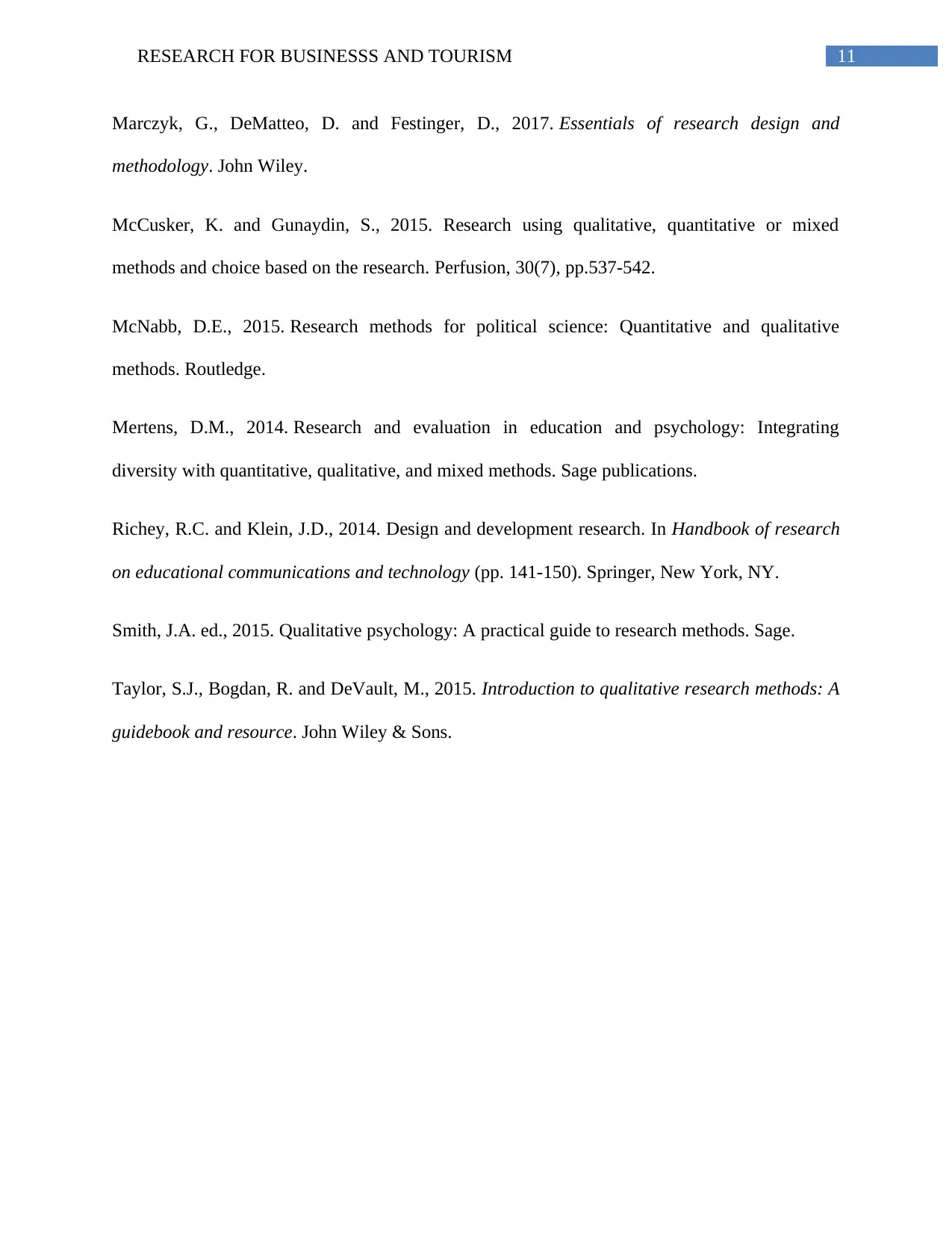
11RESEARCH FOR BUSINESSS AND TOURISM
Marczyk, G., DeMatteo, D. and Festinger, D., 2017. Essentials of research design and
methodology. John Wiley.
McCusker, K. and Gunaydin, S., 2015. Research using qualitative, quantitative or mixed
methods and choice based on the research. Perfusion, 30(7), pp.537-542.
McNabb, D.E., 2015. Research methods for political science: Quantitative and qualitative
methods. Routledge.
Mertens, D.M., 2014. Research and evaluation in education and psychology: Integrating
diversity with quantitative, qualitative, and mixed methods. Sage publications.
Richey, R.C. and Klein, J.D., 2014. Design and development research. In Handbook of research
on educational communications and technology (pp. 141-150). Springer, New York, NY.
Smith, J.A. ed., 2015. Qualitative psychology: A practical guide to research methods. Sage.
Taylor, S.J., Bogdan, R. and DeVault, M., 2015. Introduction to qualitative research methods: A
guidebook and resource. John Wiley & Sons.
Marczyk, G., DeMatteo, D. and Festinger, D., 2017. Essentials of research design and
methodology. John Wiley.
McCusker, K. and Gunaydin, S., 2015. Research using qualitative, quantitative or mixed
methods and choice based on the research. Perfusion, 30(7), pp.537-542.
McNabb, D.E., 2015. Research methods for political science: Quantitative and qualitative
methods. Routledge.
Mertens, D.M., 2014. Research and evaluation in education and psychology: Integrating
diversity with quantitative, qualitative, and mixed methods. Sage publications.
Richey, R.C. and Klein, J.D., 2014. Design and development research. In Handbook of research
on educational communications and technology (pp. 141-150). Springer, New York, NY.
Smith, J.A. ed., 2015. Qualitative psychology: A practical guide to research methods. Sage.
Taylor, S.J., Bogdan, R. and DeVault, M., 2015. Introduction to qualitative research methods: A
guidebook and resource. John Wiley & Sons.
⊘ This is a preview!⊘
Do you want full access?
Subscribe today to unlock all pages.

Trusted by 1+ million students worldwide
1 out of 14
Related Documents
Your All-in-One AI-Powered Toolkit for Academic Success.
+13062052269
info@desklib.com
Available 24*7 on WhatsApp / Email
![[object Object]](/_next/static/media/star-bottom.7253800d.svg)
Unlock your academic potential
Copyright © 2020–2025 A2Z Services. All Rights Reserved. Developed and managed by ZUCOL.



